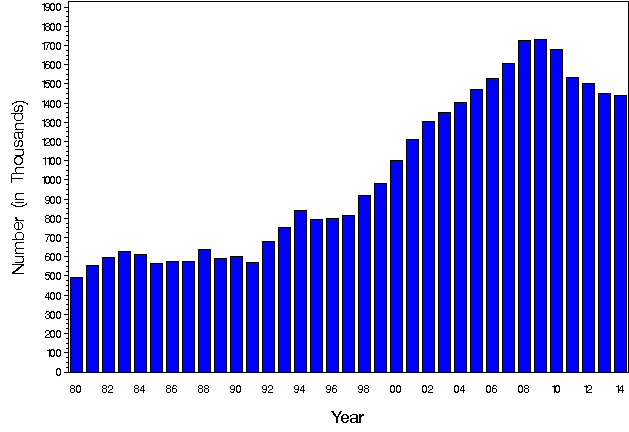
If you ask me, from my experiences as a Certified Diabetes Educator, I would have to say that diabetes is not on the decline.
Unfortunately, diabetes is actually on the rise. Every time I turn around, someone you would not suspect, and someone who does not fit the usual profile of diabetes as we used to know it, is diagnosed with it.
There is the 65 year old man who suddenly develops Type 1 diabetes following the treatment for prostate cancer.
There is the 12 year old with prediabetes, and a family history (possibly not uncommon, just undiagnosed). There is the African-American, 250 pounds 9 year old, diagnosed with MODY, or Mature Onset of Diabetes in Youth. There is the person with Type 2 diabetes, who suddenly becomes a person with Type 1 diabetes, because something unknown zaps the pancreas and completely shuts down insulin production.
There is the person with the diagnosis of Alzheimer’s disease, like my mother. Some scientists now say that Alzheimer’s disease is a type of insulin resistance.
Everywhere we now turn, there is research as to how to reverse diabetes, cure diabetes, develop an artificial or bionic pancreas to deal with it, make a new app to track it, even check your blood sugar with an app!
Diabetes is there and the numbers are increasingly growing.
I suggest reading the following:
Contents
- New York Times and others report incidence of new cases of diabetes dropping
- Are prevention and wellness efforts helping?
- We still have more than double the rate of diabetes as we did in the 1990’s
- Access to healthy foods
- Is diabetes prevalence really going down?
- Or is diabetes prevalence going up?
- Over to you
New York Times and others report incidence of new cases of diabetes dropping
A recent New York Times article entitled, “New Diabetes Cases, at long last, Begin to Fall in the United States,” recently came to my attention. It sounded interesting, but was it true? I set out to find out.
In this article, published in the New York Times on December 1, 2015, the author, Sabrina Tavernise, talks about the drop in the rate of diabetes by one fifth between 2009 and 2014. This is no joke. This number was reported by the Centers for Disease Control and Prevention, or the CDC, according to the article.
This factors out to 1.4 million new cases of diabetes in 2014, as opposed to 1.7 million new cases of diabetes in 2008. There was a visible decline. And yes, when I get to looking around, there was indeed a drop in new cases between the two years. However, the New York Times article and several other newspapers who reported the same findings forgot about one important thing: while the numbers may be low, there are still tons of diabetes cases.
I still question the whole drop from 2009 to 2014. Where I teach my Diabetes Self-Management Education classes, there are constantly new cases of diabetes being diagnosed. Where are all of those coming from?
Did they forget to count them?
Maybe it is because I live in the South, and we drink a lot of sweet tea. Maybe it is because we fry our food too much. Maybe it is because of extensive cell phone usage and a couch potato lifestyle. Maybe it is the sun, and maybe it is the moon. It beats me, but there seems to be a lot of diabetes, despite what the New York Times reports from the findings of the CDC.
Regardless, I hope the New York Times is right, and that diabetes is actually on the decline. I can always find something else in nursing to specialize in. So many good people will not have to suffer. Their families will not have to worry about their loved ones so much.
Are prevention and wellness efforts helping?
It may be that all of the effort that has been put into CDC Diabetes Prevention Programs (DPP) has caught up to the numbers. I would like to think that has something to do with it, as I have been part of that effort.
It could be that the doctors are not looking for it as much as they should be. Or it could be, as the NY Times article states, that the incidence of diabetes has simply reached its peak.
According to the CDC findings, all of our health education efforts in the area of prevention and wellness have started to have an effect on the status of the health of Americans. We have stopped drinking so many sodas, or “Pop.” We have finally started to pay attention to all the hype about portion sizes. We have started to move more, and rates of obesity have decreased.
We still have more than double the rate of diabetes as we did in the 1990’s
So like I said, do not stop the presses just yet. We still have a ton of diabetes to deal with. There is still much work to be done. Education seems to be the key, and that education is based on prevention and incorporating wellness activities into daily lifestyle.
It just goes to show that people are starting to understand that a high sedentary lifestyle and unleashed consumption of carbohydrates and fat-laden American foods can lead to diabetes and heart disease.
What can help keep diabetes on the decline?
Programs for workplace wellness, community programs for prevention and wellness, unique community opportunities, and education at the family and community level are needed to prevent Type 2 diabetes diagnosis. Organized group activities at the community level, such as heart walks and town-wide “get moving” programs keep people thinking about wellness and fitness. Awareness activities, such as health fairs, keep the community aware of the problem and the solutions available.
Health coaching and motivational interviewing
The advent and the recent surge of the health coaching movement has increased the ability of providers to provide motivational interviewing. New and innovative evidenced-based community programs have reached out into the most rural of places, with continued support through year-long programs geared toward moderate weight loss, activity, and healthy eating. Public health entities have embraced the concept of wellness and prevention, as has the Affordable Healthcare Program by providing more preventative services to all Americans.
Wellness and prevention programs
New and diverse programs should be developed to reach a broad range of populations. Programs for farm workers and migrant workers, Indians living on reservations, and programs that are delivered within the faith community are all in need of expansion across the United States in order to keep diabetes on the down slope.
Programs through health insurance companies and employers that provide people with weekly calls to remind them to take a certain medication, or to take their daily walk, have been shown to be helpful. Community support groups have helped many to stay on track, and they feel that they have a voice.
We certainly have come a long way from the days of calling diabetes “just a touch of sugar,” or calling pre-diabetes “borderline” diabetes. We have grown to have a certain respect for it, but not without after much suffering through amputations, kidney dialysis, heart disease, and countless other complications of diabetes.
Though it is unclear what exactly causes diabetes, there is a clear link between obesity and sedentary lifestyle and Type 2 diabetes in particular. We should continue to provide wellness and prevention initiatives. I believe that this is the path to keep diabetes on the decline, and all current efforts should continue, if not increase.
Even for those who already have diabetes, all of the wellness efforts geared towards preventing diabetes helps them to decrease the amount of medications that they have to take, and to live a healthier life with diabetes.
Access to healthy foods
From the school age level on up, initiatives geared towards access to healthy foods have started children off on a better foot. Michelle Obama’s school lunch programs is one example. Increasing access to healthy food items by providing fresh fruits in convenience stores, and fostering the dawn of new farmer’s markets in food deserts throughout the United States is much needed. Often times, there are farms just around the corner, but no grocery or farmer’s market where residents of a community have access to healthy food items.
In the cities, where you would think that there are no food deserts, there are areas where the people are very poor, and there is not much access to transportation. In some of these communities, there are no grocery stores. Access to healthy foods in these areas are poor, at best.
Increasing access to healthy food items, fresh fruits and vegetables and whole, not processed, foods, is key.
In addition, education in increasing the health of foods prepared in American restaurants and homes is needed. Large portions served in large containers contribute to the “super-sizing” of America, and serve only to combat any wellness efforts and community programs that already exist.
Restaurants need to realize that food that is healthy tastes good and it makes you feel good, too. They should strive to substitute high saturated fat recipes with healthier fats, add more whole grains, less sugar, and increase choices of fresh fruits and vegetables in today’s clean eating environment. Labeling should be clear and complete, and the FDA should ensure that it lists GMO’s (genetically modified organisms).
Is diabetes prevalence really going down?
The Centers for Disease Control (CDC) posted that from 2009 to 2014, prevalence went down significantly, but this is the original post and the graph below that shows an overall drastic increase in new onset diabetes cases starting in 1980, and going up steadily until 2009:
With the information below referenced straight from the CDC, the information reported by the New York Times and others is misleading. It is steadily on the rise, except where we see a drop from 2009 to 2014. However, the overall case of diabetes is so much more than it was in 1980 that it is striking.
Therefore, to only report the slight drop that occurred from 2009 to 2014 misleads the readers. The graph from the CDC below illustrates the true story. We have a continuing diabetes epidemic, with a slight drop in new diagnosis for a time. Only time will reveal whether or not there has been a drop in new cases.
Or is diabetes prevalence going up?
One study in Diabetes Care shows an increase in prevalence of Type 1 diabetes from 1.48 to 2.33 per 1000 people in the United States, a significant increase of 53 percent. Insurance data was used in the study, and only used data from children under 18 years of age. It did not address the whether or not Type 1 diabetes is rising in adults.
It is hard to tell whether or not Type 2 diabetes is going up or down. We need to see the next round of numbers before we can make further assumptions on the rise or decline of diabetes.
I have heard somewhere that only 18 percent of what we read on the internet is true. I honestly do not know if that number itself is true. It seems that these days, when major research stories are published in the newspaper, on the internet, or other social media platforms, facts are bended and twisted one way or the other to suit the author’s beliefs or the trend du jour.
I find myself often questioning the quality of journalism I read lately. It makes one wonder what true journalism is. Taking what you will from the myriad of articles you could research on the subject of whether diabetes is on the decline or not, you can come to your own conclusion.
Though I wish it were not so, my personal thoughts, based on research and facts, are that diabetes prevalence is on the rise. Though we saw a slight dip in the numbers from 2009 to 2014, I expect diabetes will be on the rise again. We must continue to do whatever we can to make the number zero or at least lessen the cases of new diagnosed diabetes patients. Until then, there is no use in sticking your head in the sand and thinking when you poke it out, diabetes will be gone.
Additional reading material:
Over to you
We invite our readers to let us know what they think of this editorial. Do you think that diabetes is on the rise or on the decline? Please share your thoughts in the comments section below. Share this article with anyone who might find it interesting and thanks for reading!
TheDiabetesCouncil Article | Reviewed by Dr. Christine Traxler MD on June 01, 2020





